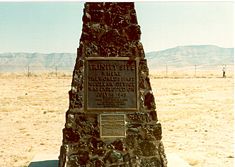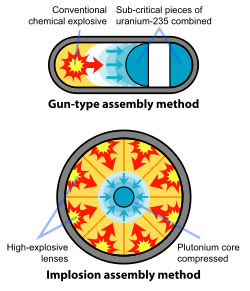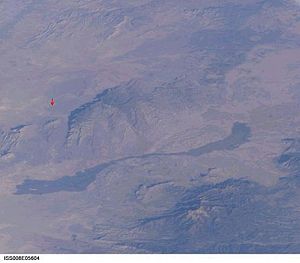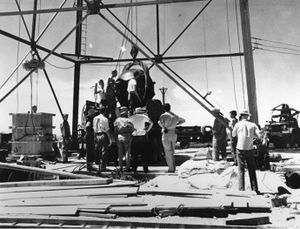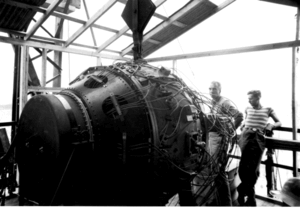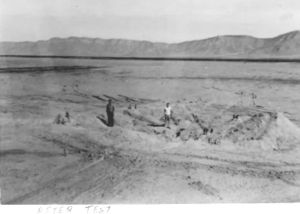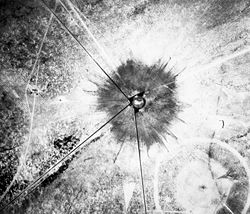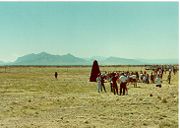Trinity (nuclear test)
2008/9 Schools Wikipedia Selection. Related subjects: Military History and War
| "Trinity" test site | |
|---|---|
 An early stage in the "Trinity" fireball, photographed by Berlyn Brixner |
|
| Type | Nuclear test site |
| Location | near San Antonio, New Mexico |
| Operator | Manhattan Engineering District (USA) |
| Status | Inactive |
| In use | July 16, 1945 |
|
Map showing location of the site |
|
| Trinity Site | |
|---|---|
| (U.S. National Historic Landmark District) | |
| Location: | Socorro, New Mexico |
| Nearest city: | Bingham |
| Area: | 36,480 acres |
| Built/Founded: | 1945 |
| Designated as NHL: | 21 Dec 1965 |
| Added to NRHP: | 15 Oct 1966 |
| NRHP Reference#: | 66000493 |
Trinity was the first test of technology for a nuclear weapon. It was conducted by the United States on July 16, 1945, at a location 35 miles (56 km) southeast of Socorro, New Mexico, on what is now White Sands Missile Range, headquartered near Alamogordo. Trinity was a test of an implosion-design plutonium bomb. The Fat Man bomb, using the same conceptual design, was dropped on Nagasaki, Japan, a few weeks later. The detonation was equivalent to the explosion of around 20 kilotons of TNT and is usually considered as the beginning of the Atomic Age.
History
The creation of nuclear weapons arose out of political and scientific developments of the late 1930s. The rise of fascist governments in Europe and new discoveries about the nature of atoms converged in the plans of the United States, United Kingdom and Canada to develop powerful weapons using nuclear fission as their primary source of energy. The Manhattan Project, as the Allied effort was called, culminated in the test of a nuclear weapon at what is now called Trinity site in July 1945, and the atomic bombings of Hiroshima and Nagasaki a few weeks later.
Development
While U.S. and British efforts to investigate the feasibility of nuclear weapons began as early as 1939, practical development began in earnest in 1942 when these efforts were transferred to the authority of the U.S. Army and became the Manhattan Project. The project was located at the top-secret Los Alamos Laboratory in New Mexico and focused both on the development of the fissile material to power the nuclear chain reactions which took place inside the weapons, and on the design of the weapons themselves.
From January 1944 to July 1945, large-scale production plants were set in operation, and the fissile material thus produced was then used to determine the features of the weapons. Multipronged research was undertaken to pursue several possibilities for bomb design. Early decisions about weapon design had been based on minute quantities of uranium-235 and plutonium created in pilot plants and laboratory cyclotrons. From these results it was thought that the creation of a bomb was as simple as shooting one piece of fissile material into another to form a critical mass.
The production of uranium-235 proved to be quite difficult with existing technology, but the production of plutonium was easier, as it was a by-product of specially constructed nuclear reactors, the first of which was developed by Enrico Fermi only in 1942. This reactor-grade plutonium was considerably less pure than cyclotron-produced plutonium however, and the presence of another isotope of plutonium in the resulting product meant that the simple "gun type" model of bomb design would not work; the presence of extra neutrons meant that the weapon would pre-detonate with a greatly reduced yield. This problem was discovered in 1942 and led to a redesign of the bomb as an "implosion" device in which a spherical core of plutonium would be compressed using conventional explosives, which would increase the plutonium's density and thus create a critical mass.
The plutonium sphere would need to be compressed on all sides exactly equally—any error would result in a "fizzle" which would simply eject the valuable plutonium and not result in a large explosion. Because of the difficulties in creating the explosive lenses for perfect compression, Manhattan Project military leader General Leslie Groves and scientific director J. Robert Oppenheimer decided that a test of the concept would have to be undertaken before a weapon could be confidently used in war. The Fat Man bomb, which used the same design, was exploded over Nagasaki on August 9, 1945, after the Trinity test proved its feasibility.
Test planning
Planning for the test was assigned to Kenneth Bainbridge, a professor of physics at Harvard University, working under explosives expert George Kistiakowsky. A site had to be located such that would guarantee secrecy of the project's goals even as it planned to detonate a nuclear weapon of unknown strength. Proper scientific equipment had to be assembled for retrieving data from the test itself, and safety guidelines had to be developed to protect personnel from the unknown results of a highly dangerous experiment. Official test photographer Berlyn Brixner set up dozens of cameras to capture the event on film.
Test site
The site was part of the Alamogordo Bombing Range, now the White Sands Missile Range. The test site was at the northern end of the range, between the towns of Carrizozo and Socorro, New Mexico, in the Jornada del Muerto in the southwestern United States (). Two bunkers were set up to observe the test. Oppenheimer and Gen. Thomas Farrell watched from a bunker ten miles from the detonation, while Gen. Groves watched at a bunker seventeen miles away.
Name
The exact origin of the name is unknown, but it is often attributed to laboratory leader J. Robert Oppenheimer as a reference to the poetry of John Donne. Oppenheimer had been exposed to Donne primarily through his former girlfriend Jean Tatlock. In 1962, General Groves wrote to Oppenheimer about the origin of the name, asking if he had chosen it because it was a name common to rivers and peaks in the West and would not attract attention. "I did suggest it, but not on that ground... Why I chose the name is not clear, but I know what thoughts were in my mind. There is a poem of John Donne, written just before his death, which I know and love. From it a quotation: 'As West and East / In all flatt Maps—and I am one—are on, / So death doth touch the Resurrection.'" ("Hymn to God My God, in My Sicknesses"). Oppenheimer continued, "That still does not make a Trinity, but in another, better known devotional poem Donne opens, 'Batter my heart, three person'd God;—.' Beyond this, I have no clues whatever." (Holy Sonnets XIV).
Test predictions
The observers set up betting pools on the results of the test. Predictions ranged from zero, a complete dud, to 18 kilotons of TNT (predicted by physicist I. I. Rabi, who won the bet), to destruction of the state of New Mexico, to ignition of the atmosphere and incineration of the entire planet (this last result had been calculated to be almost impossible, although for a while it caused some of the scientists some anxiety).
Test preparation
There was a pretest explosion of 108 tons of TNT on May 7 to calibrate the instruments. (Nuclear detonation yields have always been measured by the equivalent in tons of TNT.) For the actual test, the plutonium-core nuclear device, nicknamed the gadget, was hoisted to the top of a 20-meter steel tower for detonation — the height would give a better indication of how the weapon would behave when dropped from an airplane, as detonation in the air would maximize the amount of energy applied directly to the target (as it expanded in a spherical shape), and would generate less nuclear fallout.
The "gadget" was assembled at the nearby McDonald Ranch House, the components arriving on July 12. It was assembled on July 13 and precariously winched up the tower the following day. General Groves ordered the construction of a 240 ton steel canister code-named "Jumbo" to recover valuable plutonium if the 5 tons of conventional explosives failed to compress it into a chain reaction. The container was constructed at great expense in Pittsburgh, Pennsylvania and brought to the test site by rail but by the time it arrived the confidence of the scientists was high enough that they decided not to use it. Instead it was hoisted up in a steel tower 800 yards (730 m) from the "gadget" as a rough measure of how powerful the explosion would be. In the end, "Jumbo" survived, though its tower did not.
The detonation was initially planned for 4:00 a.m. but was postponed because of rain and lightning from early that morning. It was feared that the danger from radiation and fallout would be greatly increased by rain, and lightning had the scientists concerned about accidental detonation.
Explosion
At 4:45 a.m. a crucial weather report came in favorably, and at 5:10 a.m. the twenty-minute countdown began. Most top-level scientists and military officers were observing from a base camp ten miles (16 km) southwest of the test tower. Many other observers were around twenty miles (32 km) away, and some others were scattered at different distances, some in more informal situations (physicist Richard Feynman claimed to be the only person to see the explosion without the dark glasses provided, relying on a truck windshield to screen out harmful ultraviolet wavelengths). The final countdown was read by physicist Samuel K. Allison.
At 05:29:45 local time ( Mountain War Time), (11:29:45 GMT) the device exploded with an energy equivalent to around 20 kilotons of TNT (90 TJ). It left a crater of radioactive glass in the desert 10 feet (3 meters) deep and 1,100 ft (330 meters) wide. At the time of detonation, the surrounding mountains were illuminated "brighter than daytime" for one to two seconds, and the heat was reported as "being as hot as an oven" at the base camp. The observed colors of the illumination ranged from purple to green and eventually to white. The roar of the shock wave took 40 seconds to reach the observers. The shock wave was felt over 100 miles (160 km) away, and the mushroom cloud reached 7.5 miles (12 km) in height. As Los Alamos director J. Robert Oppenheimer watched the demonstration, he later said that a line from the Hindu scripture the Bhagavad Gita came to mind:
- I am become Death, the destroyer of worlds.
According to Oppenheimer's brother, Frank, Oppenheimer simply said, "It worked." Test director Kenneth Bainbridge replied to Oppenheimer, "Now we are all sons of bitches."
In the official report on the test, General Farrell wrote, "The lighting effects beggared description. The whole country was lighted by a searing light with the intensity many times that of the midday sun. It was golden, purple, violet, gray, and blue. It lighted every peak, crevasse and ridge of the nearby mountain range with a clarity and beauty that cannot be described but must be seen to be imagined..."
News reports quoted a forest ranger 150 miles (240 km) west of the site as saying he saw "a flash of fire followed by an explosion and black smoke." A New Mexican 150 miles (240 km) north said, "The explosion lighted up the sky like the sun." Other reports remarked that windows were rattled and the sound of the explosion could be heard up to 200 miles (320 km) away.
John R. Lugo was flying a U.S. Navy transport at 10,000 feet, 30 miles east of Albuquerque, en route to the West Coast. "My first impression was, like, the sun was coming up in the south. What a ball of fire! It was so bright it lit up the cockpit of the plane." Lugo radioed Albuquerque. He got no explanation for the blast, but was told, "Don't fly south."
In the crater, the desert sand, which is largely made of silica, melted and became a mildly radioactive light green glass which was named Trinitite. The crater was filled in soon after the test.
The Alamogordo Air Base issued a 50-word press release in response to what it described as "several inquiries" that had been received concerning an explosion. The release explained that "a remotely located ammunitions magazine containing a considerable amount of high explosives and pyrotechnics exploded," but that "there was no loss of life or limb to anyone." A newspaper article published the same day stated that "the blast was seen and felt throughout an area extending from El Paso to Silver City, Gallup, Socorro, and Albuquerque." The actual cause was not publicly acknowledged until after the August 6 attack on Hiroshima.
The Manhattan Project's official journalist, William L. Laurence, had put multiple press releases on file with his office at The New York Times to be released in case of an emergency, ranging from an account of a successful test (the one which was used) to more macabre scenarios explaining why all of the scientists had perished in a single freak accident.
Around 260 personnel were present, none closer than 5.6 miles (9 km). At the next test series, Operation Crossroads in 1946, over 40,000 people were present.
Test results
The results of the test were conveyed to President Harry S. Truman and were used as leverage in his negotiations with the Soviet Union at the Potsdam Conference.
Information about the Trinity test was made public shortly after the bombing of Hiroshima. The Smyth Report, released on August 12, 1945, gave some information on the blast, and the hardbound edition released by Princeton University Press a few weeks later contained the famous pictures of a "bulbous" Trinity fireball.
Oppenheimer and Groves posed for reporters near the remains of the mangled test tower shortly after the war. In the years after the test, the pictures have become a potent symbol of the beginning of the so-called " Atomic Age", and the test has often been featured in popular culture.
First deployment
Following the success of the Trinity test, two bombs were prepared for use against Japan during World War II. The first, dropped on Hiroshima, Japan, on August 6, was code-named " Little Boy", and used uranium-235 as its fission source. It was an untested design but was considered very likely to work and was considerably simpler than the implosion model. It could not be tested because there was only enough uranium-235 for one bomb. The second bomb, dropped on Nagasaki, Japan, on August 9, was code-named " Fat Man", and was a plutonium bomb of the type tested at Trinity. The atomic bombings of Hiroshima and Nagasaki killed at least 148,000 people immediately and many more over time. By 1950, the death toll was over 340,000. They were followed days later by the surrender of Japan. Debate over the justification of the use of nuclear weapons against Japan persists to this day, both in scholarly and popular circles.
Site today
In 1952, the site of the explosion was bulldozed and the remaining trinitite was disposed of. On December 21, 1965, Trinity Site was declared a National Historic Landmark district, and was listed on the National Register of Historic Places on October 15, 1966.
More than sixty years after the test, residual radiation at the site measured about ten times higher than normal. The amount of exposure received during a one-hour visit to the site is about half of what a U.S. adult receives on an average day from natural and medical sources. The Trinity monument, a rough-sided, lava rock obelisk around 12 feet (3.65 m) high, marks the explosion's hypocenter, and "Jumbo" is still kept nearby.
The site is still a popular destination for those interested in atomic tourism, though it is only open to the public twice a year, on the first Saturdays of April and October. On July 16, 2005, a special tour of the site was conducted to mark the 60th anniversary of the Trinity test, and hundreds (some news sources reported thousands) of visitors arrived to commemorate the occasion.

